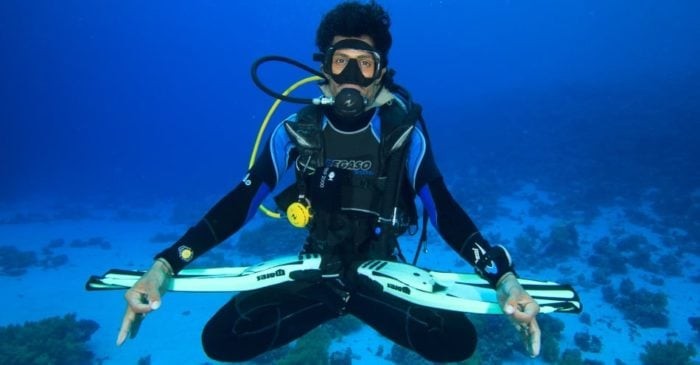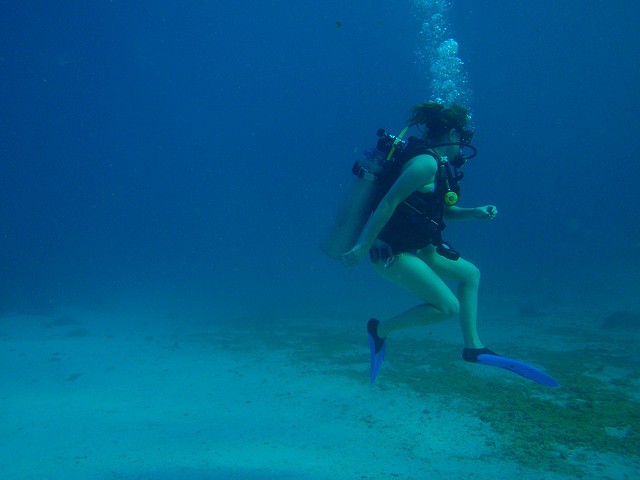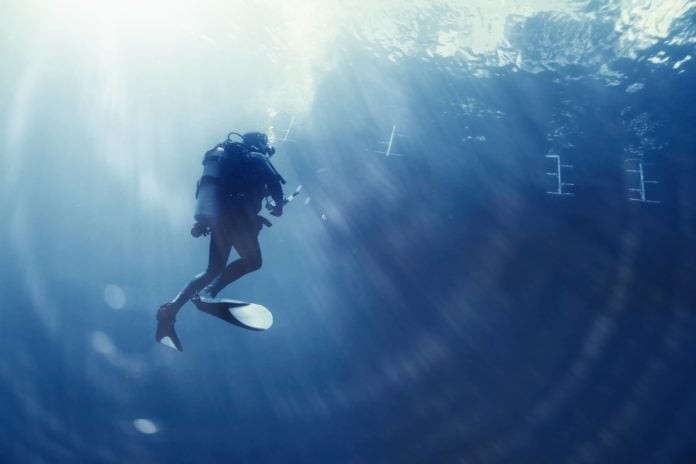I recently was diving in the Berry Islands located in the Out Islands, Bahamas. We were doing a dive from the shore assisted by a rescue sled behind a jet ski. The dive profile was shallow. We started at only 10 feet, then went over the edge down to the bottom at 40 feet and followed along the reef, rounding the end of the reef, we followed a slope back to where we started. Our dive brief instructed us that before we began we would each submerge, check our buoyancy, returned to the surface and let the dive leader know if we were properly weighted. You will hear a number of different ways to see if you are properly weighted at the beginning of a dive, but most of them then say add four or five pounds to compensate for the added buoyancy as you use the air in your cylinder.
There was three divers plus the dive master on the dive. Diver “A” said he had been a certified diver for about a year and had 86 dives. He was diving with a large camera rig. Diver “B” said he was an Advance Open Water diver, certified for 3 years and had 130 dive. Then there was myself. I wanted to see how the other divers checked if they had enough weight and went down first. Diver “A” sank to the bottom, knelled on the sand and added some air to his BCD before heading back up. Diver “B” went a little more slowly down and a few feet from the bottom assumed a floating Buddha position. For myself, I descended slowly and became horizontal a few feet above the bottom.

The Alert Diver magazine has a very nice quote in their Fall 2011 issue. They say:
“Good buoyancy begins with proper weighting. It is imperative the amount of weight you use allows you to descend, not causes you to do so.”
Proper weighting is very important for buoyancy control, however, there are other elements involved. The exercise that the dive leader had us do could only tell us if we were greatly over or under weighted but not if we had good buoyancy control. In my article about Buoyancy control in the Beginner Guide to Scuba Diving I discussed proper weighting and related topics, in this article I want to expand on some of that information.
Proper Weighting
When you are at your safety stop with your scuba tank having slightly more than your minimum pressure you should be neutrally buoyant with no air in your BCD. This is the goal you want to create. Getting to that point will take trail and error. However, having the proper weights increases the safety of the diver and improves the divers underwater performance. When you are over weighted, you need to add more air to your BCD to offset the weight. The extra air adds resistance in the water, also it will increase the exposure of your chest to the water you are moving against. Depending on the amount of weight that is extra and your depth it is possible that your fully inflated BCD is insufficient to return you to the surface. It has been estimated that the majority of divers are over-weighted with many carrying more that 10 extra pounds. All too often divers sink to the bottom, often colliding with the reef as they attempt to inflate their BCD to stop their descent. Divers should decent just slightly negative allowing their bodies to control the descent, not gravity. With a slow descent, a change of body position and maybe a small puff of air will stop you before the crash.
Balance Equipment
Trim is a very important portion of buoyancy control. The most efficient position for your body to be in is flat and horizontal in the water. Ideally, our shoulders, hips, and knees should be on the same plane. This position provides the least resistance as we move through the water. Our bodies have a natural center of gravity, that point acts as a fulcrum point when we are in the water. However, the center of gravity might not be our center of weight. Naturally, our legs are denser than other parts of our body. Also, the length of the legs can create leverage, similar to one side being longer on a see-saw. This causes the body to drop the legs below the center of gravity and if we remain unbending causes the chest to rise. If our knees are in the proper position and we bend our knees bringing our legs more vertical, we move the weight closer to the center of gravity. This “shorter” length of our legs reduces the leverage. It is interesting to note that the best body positions for a trimmed scuba diver are very similar to that of a skydiver.

Most people are naturally slightly positive buoyant with a normal breath. However, if vertical the balance of buoyancy might be above the mouth and nose. Wearing an exposure suit can help us become more buoyant and allow us to more easily keep our head out of the water. To go fully under we will need to add some weight. However, where we place that weight will impact our trim. If you are wearing a weight belt, it is likely on the leg side of the center of gravity giving additional tenancy to drop the feet. Air, being lighter than water, will try to rise towards the surface. This is what gives our BCD the lift that we need to counter extra weight. Inside the BCD the air will rise to the highest point if you are in a position where your chest is higher the air will move towards the shoulders making the top half more buoyant. If you are flat that lift if spread over a wider area and closer to the center of gravity.
The key is to use our bodies natural tendencies, the equipment you are using and the weight that you are adding in a way that they are balanced around the center of gravity. A BCD with integrated weights places the weight closer and often above the center of gravity.
The diver that assumed the floating Buddha position might have looked good while doing it, but, it really did not help him while diving. As we were diving, I noticed that his feet were much lower than the rest of his body. His body was not straight and the angle his body was in the water differed between his chest and legs. I would say that it appeared that at the least a portion of each of his kicks was pushing his body to pivot.
One of the websites I read, Cave Diver Harry, has a number of articles about buoyancy control including one about why Buddha hovers are not an effective training tool. One practice, the fin pivot, is also mentioned in his articles. If you think about it, the goal you practice in a fin pivot is exactly what you do not want while diving. While practices like fin pivots and the Buddha hover are no longer described in the official training materials it is still practiced.
Breathing Control
Our lungs are huge air sacks, that we do not always use to their maximum volume. If we are neutrally balanced with a normal breath, increasing the amount of air in our lungs will give us a positive buoyancy. Conversely holding an exhale a little longer than normal or taking a shallower breath will make us slightly negative buoyant causing us to sink. As we become more comfortable underwater, our breathing patterns will stabilize. Once we have that stabilization the task of buoyancy control becomes easier. One interesting point to remember is that the pioneer divers did not use a BCD. They relied on being properly weighted and use their breathing to make minor changes in their buoyancy. The only flotation device they used were horse collars that were for surface use.
BCD usage
While the pioneer divers did not use a BCD they are almost universally used today. How often they are adjusted underwater depends on many factors. They should be used primarily to compensate for wet suit compression and to offset the buoyancy change due to using the gas in your cylinders. Most divers use then much more often than that. Divers often rely on the buttons on the BCD inflater to adjust their depths. This common practice uses extra air and increases resistance underwater.
Ensuring that our BCD is properly fitted and properly worn will go a long way to improving your buoyancy control. If we are constantly changing our equipment placement on each dive, our body will not train properly.
The Diver’s Brain
Maybe the least use underwater buoyancy control tool is the divers brain. Thinking ahead will reduce the need to rapidly add air to a BCD to keep from crashing into a wreck and then releasing some of that air because you are now floating up. Also, actions like that can increase stress which makes you breathe harder. That in turn, decreases your control. Keep calm so that you think head and act not react.
One Dive instructor I have had the privilege to dive with on occasion is named Andy Davis (no relation). He has an excellent series of articles on mastering buoyancy control. His articles go into more depth into the finer points.


